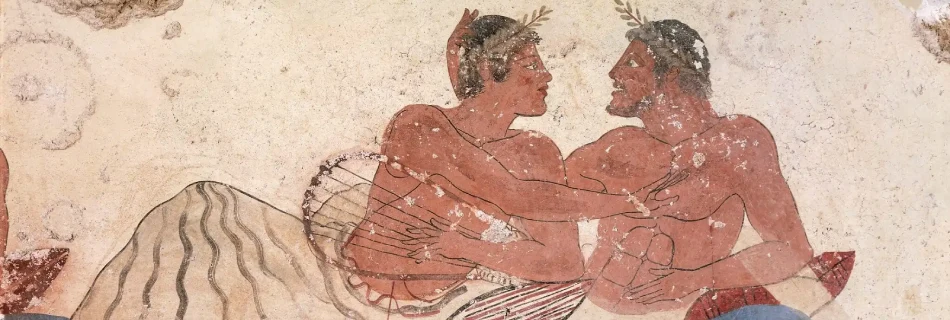
Homosexuality was a common practice in ancient Greece, and it was not considered taboo or sinful. In fact, it was often celebrated in art, literature, and society. The ancient Greeks believed that love and desire were not limited by gender, and that both men and women could experience same-sex attraction. Many famous figures in ancient Greek history, such as Plato, Socrates, and Alexander the Great, were known to have had same-sex relationships. However, it's important to note that the ancient Greek attitudes towards homosexuality were different from modern Western attitudes, and it's not appropriate to apply modern concepts of sexuality to ancient cultures.
Ancient Greek Homosexuality
Ancient Greek homosexuality is a fascinating and complex topic that has intrigued scholars and historians for centuries. In ancient Greece, same-sex relationships were not only accepted but were also considered an integral part of the social and cultural fabric of the time. However, it's important to understand that the concept of homosexuality in ancient Greece was vastly different from the modern-day understanding of the term.
For the ancient Greeks, sexual attraction to both men and women was considered natural and normal. Same-sex relationships were often seen as a way to express love and affection between individuals of the same gender, and it wasn't uncommon for men to have both male and female partners at the same time.
Furthermore, ancient Greek homosexuality was not limited to sexual relationships but also included a strong emotional and intellectual bond between individuals. Same-sex relationships were often seen as a way for men to mentor and guide younger men, passing on knowledge and wisdom.
However, it's important to note that ancient Greek homosexuality was not universally accepted, and there were certain social and cultural norms that governed same-sex relationships. Additionally, the role of women in same-sex relationships is often overlooked due to the patriarchal nature of ancient Greek society.
Overall, understanding ancient Greek homosexuality requires a nuanced and contextual understanding of the social, cultural, and historical factors that shaped the practice.
Historical Context of Homosexuality in Ancient Greece
Homosexuality in ancient Greece was viewed very differently than it is today. In fact, it was considered a normal and accepted practice among men. However, the context in which homosexuality existed in ancient Greece was vastly different from the world we live in now.
In ancient Greece, the concept of homosexuality was not based on sexual orientation, but on power dynamics. Men were considered superior to women, and therefore, relationships between men were often seen as a way to reinforce this power dynamic. The older man in the relationship would be seen as the dominant partner, while the younger man was seen as the submissive partner.
Additionally, homosexuality in ancient Greece was largely limited to certain social classes. Wealthy men were more likely to engage in homosexual relationships, while lower class men were not able to afford such relationships. It was also common for men to have both a wife and a male lover.
It is important to note that while homosexuality was accepted in ancient Greece, it was not necessarily celebrated. There were certain societal expectations surrounding the practice, and men who were seen as overly effeminate were often ridiculed.
Overall, the historical context of homosexuality in ancient Greece was vastly different from the world we live in today. While it was accepted and normalized in certain social circles, it was based on power dynamics rather than sexual orientation, and was not necessarily celebrated or embraced by all members of society.
The Myths and Legends Involving Homosexuality in Ancient Greece
In Ancient Greece, homosexuality was not only reflected in everyday life but also in mythology and legends. The Greek pantheon was filled with deities and heroes who had homosexual relationships, signifying the cultural acceptance of such relations. One notable example is the relationship between Zeus, the king of the gods, and Ganymede, a mortal prince. Zeus was so captivated by Ganymede's beauty that he transformed into an eagle to abduct him, making Ganymede an immortal cupbearer in Olympus. The relationship between Achilles and Patroclus, interpreted by some as romantic, is another example. By looking into these mythological accounts, we gain deeper insights into how homosexuality was perceived and integrated into Ancient Greek culture.
Delving deeper, we find that these mythological tales held substantial influence over societal norms and practices. The legend of Apollo and Hyacinthus, a beautiful Spartan prince, is another notable example. Their relationship was celebrated, and upon Hyacinthus' untimely death, Apollo's mourning resulted in the creation of the hyacinth flower. This legend was not just a tale, but it was often cited as a precedent for relationships between older and younger males in Spartan society, showcasing a deep cultural connection.
Similarly, the relationship between the goddess Artemis and her handmaiden Callisto could be interpreted as a reflection of lesbian relationships, although it is less explicit than the examples involving male characters. It's critical to understand that these relationships were not only accepted but also cherished, as they were integral to the legends of the gods themselves.
By examining these legends and myths, we can glean a lot about the nuances of sexuality in Ancient Greek society. They underline the acceptance, or even reverence, towards homosexuality, offering us a different perspective from a time far removed from ours.
The Role of Homosexuality in Ancient Greek Society and Culture
Homosexuality played a significant role in ancient Greek society and culture. It was not only accepted but was also celebrated and considered to be a normal part of life. In fact, the Greeks believed that love between two men was the purest form of love, and it was often celebrated in their literature, art, and even religious ceremonies.
The Greeks believed that love between two men was based on a deep emotional and intellectual connection, rather than just physical attraction. This type of love was known as "philos," which meant friendship or brotherly love. It was seen as a way to form strong bonds and alliances between men, especially in times of war or political turmoil.
In addition to "philos," the Greeks also celebrated "eros," which was romantic love and sexual desire between two men. This type of love was often depicted in their art, literature, and even in their religious festivals. For example, the festival of Dionysus, the god of wine and fertility, was famous for its wild and uninhibited celebrations, which often included same-sex encounters.
Homosexuality was not limited to the upper classes or the elite. It was present in all levels of society, and even slaves were known to engage in same-sex relationships. However, it was not without its restrictions and taboos. For example, it was considered unacceptable for an older man to pursue a younger man, and there were strict rules about how these relationships should be conducted.
Despite these restrictions, homosexuality was still an integral part of ancient Greek society and culture. It was celebrated in their art, literature, and religious festivals, and it played an important role in forming strong bonds and alliances between men.







